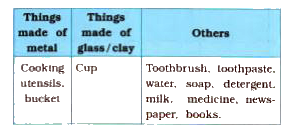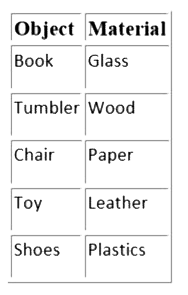Make a list of ten things you have used or consumed since morning.
Compile this list with the lists made by your classmates and then sort the items into the adjascent table.
If there are items which are made up of more than one material, put them into both the relevant columns.
A list of ten things used or consumed since morning is given below :
Toothbrush, toothpaste, bucket, water, soap, detergent, cooking utensils, cup, milk, medicine, newspaper, books.

Topper's Solved these Questions
- CARBON AND ITS COMPOUNDSBook:KUMAR PRAKASHANChapter:CARBON AND ITS COMPOUNDSExercise:TEXTUAL EXERCISE
Explore 14 Videos
- CARBON AND ITS COMPOUNDSBook:KUMAR PRAKASHANChapter:CARBON AND ITS COMPOUNDSExercise:ADDITIONAL QUESTIONS AND ANSWERS
Explore 8 Videos
- CARBON AND ITS COMPOUNDSBook:KUMAR PRAKASHANChapter:CARBON AND ITS COMPOUNDSExercise:Practical Skill Based Questions With Answers
Explore 10 Videos
- ACID , BASES AND SALTBook:KUMAR PRAKASHANChapter:ACID , BASES AND SALTExercise:Activity
Explore 47 Videos
- CHEMICAL REACTIONS AND EQUATIONS Book:KUMAR PRAKASHANChapter:CHEMICAL REACTIONS AND EQUATIONS Exercise:PRACTICAL SKILL BASED QUESTIONS WITH ANSWERS
Explore 5 Videos
Similar Questions
Knowledge Check
All the listed things below are made of flint glass. Which one of these have greatest dispersive power (ω).
AprismBglass slabCbiconvex lensDall have same ωRead the passage and answer the questions.
You hope to do several things every day. At the end of each day, most of them are not done. You may make a to-do list but discover in a short while that it is not helping you much. Tasks keep adding to it. In a few weeks, it starts looking like a list of things you will never do and you feel stressed about it. Making a to-do list is not enough. It is useful only when you understand the key aspects of it and work on it further. To begin with, recognise that a to-do list is only a pool of tasks. It is just a raw collection that tells you nothing about how you will get to it. To make it useful you have to define the 'when'. When you begin creating a schedule, your focus shifts to how long you have to work on each task to complete it. This way you are forced to be realistic about your goals. Since you cannot complete all tasks on the same day, you need to prioritise. Rank the tasks in order of importance. Now, start working according to the schedule paying close attention to how you are spending the day. Another way to prioritise tasks is based on the creative energy they require. Separate the tasks into creative and boring ones. This approach helps you to stay productive even during cheerless parts of the day.
A to-do list becomes useful when we:Aadd to it all tasks to be doneBcomplete all tasks listedCgive a time line to the tasksDare productive all dayRead the passage and answer the questions.
You hope to do several things every day. At the end of each day, most of them are not done. You may make a to-do list but discover in a short while that it is not helping you much. Tasks keep adding to it. In a few weeks, it starts looking like a list of things you will never do and you feel stressed about it. Making a to-do list is not enough. It is useful only when you understand the key aspects of it and work on it further. To begin with, recognise that a to-do list is only a pool of tasks. It is just a raw collection that tells you nothing about how you will get to it. To make it useful you have to define the 'when'. When you begin creating a schedule, your focus shifts to how long you have to work on each task to complete it. This way you are forced to be realistic about your goals. Since you cannot complete all tasks on the same day, you need to prioritise. Rank the tasks in order of importance. Now, start working according to the schedule paying close attention to how you are spending the day. Another way to prioritise tasks is based on the creative energy they require. Separate the tasks into creative and boring ones. This approach helps you to stay productive even during cheerless parts of the day.
Which of the following is NOT correct?AA long to-do list may cause stress.BTasks may keep adding to the to-do list.CAll tasks are boring to do.DIt is important to prioritise tasks.
Compile a list of some of the towns, cities, rivers, seas and provinces mentioned in this chapter, and then try and find them on the maps. Can you say something about any three of the items in the list you have compiled?
View SolutionList the materials used to make beads in the Harappan civilisation. Describe the process by which any one kind of beads are made.
View SolutionAll the listed things below are made of flint glass. Which one of these have greatest dispersive power (ω).
View SolutionMatch the objects given below with the materials from which they could be made. Remember, an object could be made from more than one material and a given material could be used for making many objects.

View SolutionMatch the objects given below with the materials from which they could be made. Remember, an object could be made from more than one material and a given material could be used for making many objects.

View Solution
